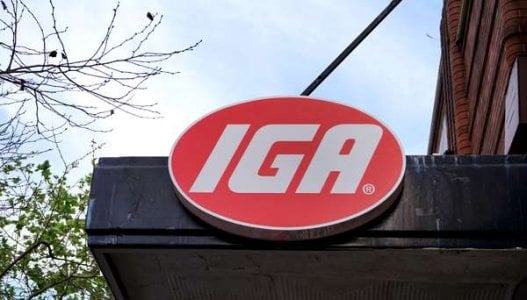Cash-ing in on savings: Supermarket’s discount sparks return to paper money
- Replies 29
In an era where tapping a card or phone has become second nature, it's refreshing to see a business that not only values the traditional method of payment but rewards it.
A leading supermarket chain has introduced enticing discounts for customers who choose to use cash in a bid to attract shoppers and address recent concerns about payment methods.
This move comes in response to growing frustration over extra charges associated with card payments, aiming to provide relief and savings for those who prefer traditional payment methods.
The IGA in Richmond, Tasmania, is leading a charge that could see a resurgence in the use of cold, hard cash by offering a generous 5 per cent discount to customers who pay with it.
Kosta Tzortzis, the owner of the Richmond IGA, expressed his hope that the modest discount would motivate customers to continue using cash while also assisting elderly customers and those who don't use bank cards.
‘When you take into account all the bank fees and the transaction fees, small businesses don’t get to see much of the cash,’ he said.
‘You pay $50 by card by the time you do 10, 15 transactions there’s not much of it left with all the fees and surcharges. Whereas cash is cash and 10, 15 transactions later, it is still $50.’

Mr Tzortzis, whose father purchased the shop in 1980, noted that digital payments have surpassed cash as the main payment method.
According to the Reserve Bank of Australia (RBA), cash payments made up 13 per cent of consumer transactions in 2022.
Before the IGA introduced the discount nearly two years ago, about 80 per cent of customers were using EFTPOS, while 20 per cent used cash.
The discount has since ‘pushed it back a little bit’, with current usage at 70 per cent card payments and 30 per cent cash.
‘People are still coming in and paying with their phone or their watch. It's scary the way things are going,’ Mr Tzortzis remarked.
Many Australians have lauded IGA Richmond for providing the discount, with some calling the owner a ‘legend’ and others wishing their local IGA would adopt a similar policy.
In addition to merchant fees, card payment costs can be transferred to customers.
Australians spent a total of $1 billion on surcharges last year, and a recent analysis by Canstar revealed that the average Australian paid around $140 annually in these fees.
‘I get slugged with the surcharges, and if I have to accept cards, I pass on the surcharge that I get charged back to the customer,’ Mr Tzortzis shared.
‘I’ve managed to get my surcharges down to 0.35 per cent for credit cards like Visa or Mastercard. If it is a pure bank card there is no surcharge.’
An increasing number of Australian businesses are now offering discounts to customers who choose to pay with cash, with some providing up to 50 per cent off or even a free drink or item.
Dr Angel Zhong, an associate professor of finance at RMIT, noted that these discounts tend to be more common in regional and remote areas compared to metropolitan locations.
‘The adoption rate of digital payments is lower in regional areas where you don’t have robust and strong internet infrastructure. There is also a degree of digital literacy,’ she pointed out.
‘In metropolitan areas, there is an increasing trend that people prefer to use digital payments.’
Dr Zhong observed that customers in metropolitan areas are generally more accepting of card surcharges, whereas those in remote areas often show a stronger preference for cash.
‘If businesses impose surcharges, it will push their customers away. But if they don’t impose the surcharge, then that means they have to bear the cost on their own,’ she said.
‘They are facing this dilemma which is why they want to attract people who prefer to use cash and do this sort of discount.’
Richy Marchandise, owner of Melbourne's Mimolette Café, implemented a 10 per cent discount for customers who pay with cash.
He cited ‘so many things’ wrong with EFTPOS, including unreliable service, hidden fees for merchants, and payment delays.
Dr Zhong noted that there are still ‘hidden costs’ linked to using cash.
‘Research shows that, on average, it takes a small business in Australia 29 days per year to handle cash,’ she explained.
‘That includes receiving cash, counting cash, reconciling and depositing cash.’
Dr Zhong also highlighted concerns about cash being used in the ‘shadow economy’ to hide transactions and evade taxes.
‘As consumers, as long as the payment is recorded and declared by the business, there’s nothing wrong if you go with the cash option,’ she stated.
Mr Tzortzis acknowledged that some of his customers had raised concerns about this issue but emphasised that he was not attempting to evade any of his obligations with the cash discount.
‘It all goes through the till, so it’s not like I can put anything aside. Nowadays, it is all scrutinised and reported,’ he explained.
He mentioned that he was not aware of other IGA stores offering discounts for cash payments.
Since IGAs are independently owned and operated, each store owner makes decisions based on their specific store and local community.
As supermarkets begin to offer cash discounts in response to growing concerns over card surcharges, Australians are grappling with the broader implications of a shift towards digital payments.
While some businesses are championing cash transactions to ease the financial burden on customers, there's a growing debate about why many Australians remain resistant to a cashless future despite the rapid rise of digital payment methods.
This evolving landscape reflects a deeper conversation about the balance between convenience and traditional payment preferences.
 Have you taken advantage of cash discounts at your local stores? Do you prefer the convenience of digital payments, or are you a staunch supporter of cash? Share your thoughts and experiences in the comments below!
Have you taken advantage of cash discounts at your local stores? Do you prefer the convenience of digital payments, or are you a staunch supporter of cash? Share your thoughts and experiences in the comments below!
A leading supermarket chain has introduced enticing discounts for customers who choose to use cash in a bid to attract shoppers and address recent concerns about payment methods.
This move comes in response to growing frustration over extra charges associated with card payments, aiming to provide relief and savings for those who prefer traditional payment methods.
The IGA in Richmond, Tasmania, is leading a charge that could see a resurgence in the use of cold, hard cash by offering a generous 5 per cent discount to customers who pay with it.
Kosta Tzortzis, the owner of the Richmond IGA, expressed his hope that the modest discount would motivate customers to continue using cash while also assisting elderly customers and those who don't use bank cards.
‘When you take into account all the bank fees and the transaction fees, small businesses don’t get to see much of the cash,’ he said.
‘You pay $50 by card by the time you do 10, 15 transactions there’s not much of it left with all the fees and surcharges. Whereas cash is cash and 10, 15 transactions later, it is still $50.’

An IGA in Richmond, Tasmania, is offering a 5 per cent discount for cash payments to encourage cash use and assist the elderly and those without bank cards. Credit: Shutterstock
Mr Tzortzis, whose father purchased the shop in 1980, noted that digital payments have surpassed cash as the main payment method.
According to the Reserve Bank of Australia (RBA), cash payments made up 13 per cent of consumer transactions in 2022.
Before the IGA introduced the discount nearly two years ago, about 80 per cent of customers were using EFTPOS, while 20 per cent used cash.
The discount has since ‘pushed it back a little bit’, with current usage at 70 per cent card payments and 30 per cent cash.
‘People are still coming in and paying with their phone or their watch. It's scary the way things are going,’ Mr Tzortzis remarked.
Many Australians have lauded IGA Richmond for providing the discount, with some calling the owner a ‘legend’ and others wishing their local IGA would adopt a similar policy.
In addition to merchant fees, card payment costs can be transferred to customers.
Australians spent a total of $1 billion on surcharges last year, and a recent analysis by Canstar revealed that the average Australian paid around $140 annually in these fees.
‘I get slugged with the surcharges, and if I have to accept cards, I pass on the surcharge that I get charged back to the customer,’ Mr Tzortzis shared.
‘I’ve managed to get my surcharges down to 0.35 per cent for credit cards like Visa or Mastercard. If it is a pure bank card there is no surcharge.’
An increasing number of Australian businesses are now offering discounts to customers who choose to pay with cash, with some providing up to 50 per cent off or even a free drink or item.
Dr Angel Zhong, an associate professor of finance at RMIT, noted that these discounts tend to be more common in regional and remote areas compared to metropolitan locations.
‘The adoption rate of digital payments is lower in regional areas where you don’t have robust and strong internet infrastructure. There is also a degree of digital literacy,’ she pointed out.
‘In metropolitan areas, there is an increasing trend that people prefer to use digital payments.’
Dr Zhong observed that customers in metropolitan areas are generally more accepting of card surcharges, whereas those in remote areas often show a stronger preference for cash.
‘If businesses impose surcharges, it will push their customers away. But if they don’t impose the surcharge, then that means they have to bear the cost on their own,’ she said.
‘They are facing this dilemma which is why they want to attract people who prefer to use cash and do this sort of discount.’
Richy Marchandise, owner of Melbourne's Mimolette Café, implemented a 10 per cent discount for customers who pay with cash.
He cited ‘so many things’ wrong with EFTPOS, including unreliable service, hidden fees for merchants, and payment delays.
Dr Zhong noted that there are still ‘hidden costs’ linked to using cash.
‘Research shows that, on average, it takes a small business in Australia 29 days per year to handle cash,’ she explained.
‘That includes receiving cash, counting cash, reconciling and depositing cash.’
Dr Zhong also highlighted concerns about cash being used in the ‘shadow economy’ to hide transactions and evade taxes.
‘As consumers, as long as the payment is recorded and declared by the business, there’s nothing wrong if you go with the cash option,’ she stated.
Mr Tzortzis acknowledged that some of his customers had raised concerns about this issue but emphasised that he was not attempting to evade any of his obligations with the cash discount.
‘It all goes through the till, so it’s not like I can put anything aside. Nowadays, it is all scrutinised and reported,’ he explained.
He mentioned that he was not aware of other IGA stores offering discounts for cash payments.
Since IGAs are independently owned and operated, each store owner makes decisions based on their specific store and local community.
As supermarkets begin to offer cash discounts in response to growing concerns over card surcharges, Australians are grappling with the broader implications of a shift towards digital payments.
While some businesses are championing cash transactions to ease the financial burden on customers, there's a growing debate about why many Australians remain resistant to a cashless future despite the rapid rise of digital payment methods.
This evolving landscape reflects a deeper conversation about the balance between convenience and traditional payment preferences.
Key Takeaways
- An IGA in Richmond, Tasmania, is offering a 5 per cent discount to customers who pay with cash to encourage the use of cash and support the elderly and those without bank cards.
- The store's owner, Kosta Tzortzis, is aiming to counteract the transaction fees and bank charges associated with card payments and has seen a shift in payment methods since the discount was implemented.
- The Reserve Bank of Australia found that cash payments accounted for 13 per cent of consumer payments in 2022, but digital payments are increasingly becoming the norm.
- Some Australians are supportive of the cash payment discount, as it helps mitigate the surcharges passed onto customers, which collectively added up to $1 billion in surcharges paid by Australians last year.







